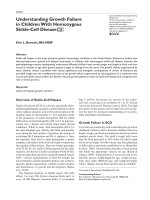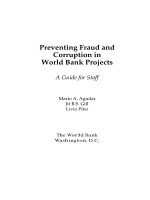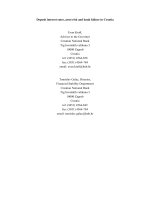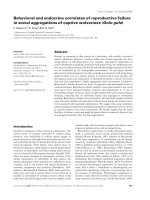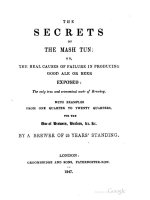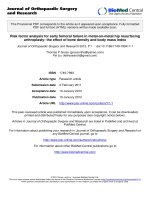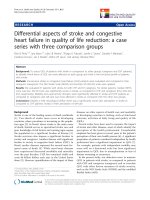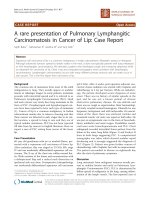AEGIS presentation preventing bearing fluting failure in VFD driven motors ASHRAE
Bạn đang xem bản rút gọn của tài liệu. Xem và tải ngay bản đầy đủ của tài liệu tại đây (3.66 MB, 31 trang )
Shaft Grounding Rings
Protecting VFD Driven Motors
from Bearing Currents
Copyright 2010 – Electro Static Technology-ITW – Patented Technology – All Rights Reserved
Variable Frequency Drives
and Electric Induction Motors
When pulse width modulation (PWM) Variable Frequency Drives
(VFDs) were developed using insulated gate bipolar transistors
(IGBTs), this new technology was used to control electric induction
motors in industrial and commercial applications. The advantages
were obvious:
• Torque and motor speed could now be precisely controlled to
optimize both process and energy requirements.
• The potential to save energy by operating motors at only the
needed speed while maintaining torque requirements could
potentially result in a 20% to 50% energy savings.
• Processes could be optimized and controlled by computer
processing systems to achieve productivity increases or energy
savings.
2
Copyright 2010 – Electro Static Technology-ITW – Patented Technology – All Rights Reserved
Energy Savings through the use of
Variable Frequency Drives
The use of VFD’s result in significant energy savings
with payback periods often less than one year
100% Speed
100% Load
100hp Induction Motor
60% Speed
22% HP
100hp Induction Motor
Cost per year $27,000
Cost per year $6,000
Bearing Protection Helps Guarantee the savings
3
Copyright 2010 – Electro Static Technology-ITW – Patented Technology – All Rights Reserved
Bearing failures are costly…take care of them…you don’t want to
deal with this…
Typical Bearing Failure Cost:
Rigging/Removal and replacement
Motor Repair
Production Downtime
Total
Cost of AEGIS™ installed on Marathon motor
to Prevent Bearing Fluting Failure
Return on Investment
Small Motor
10 HP/215T
Large Motor
300 HP/449T
$1,000
$2,000
$990
$13,200
$10,000
$100,000
$11,990
$115,200
$456
$1,327
2629%
8681%
4
Copyright 2010 – Electro Static Technology-ITW – Patented Technology – All Rights Reserved
Bearing Failure Reports
ABB Technical Guide No.5, 2000: “Some new drive
installations can have their bearings fail only a few months
after start-up…”
Emerson (US motors), Product service bulletin, Vol.3, Dec/2002: “In
the past few years, there has been a significant increase in motor
problems associated with shaft voltages and currents.”
WEG Electric Motors, June/2003: “Recently though, it has become
apparent that these improvements have been bought at a price: IGBT
technology has resurrected bearing problems due to electrical damage,
creating a new challenge to manufacturers of electric motors…”
IEEE 2004, IAS 2004, 0-7803-8486-5/04: “The surfaces of the bearing races
of bearings with operation time greater than 500 h are melted several times
at the whole surface due to small craters…..”, A. Muetze, A.Binder, H.Vogel,
J.Hering, “ Experimental Evaluation of the Endangerment of Ball Bearings
due to Inverter-Induced Bearing Currents”, pp. 1989 – 1995
5
Copyright 2010 – Electro Static Technology-ITW – Patented Technology – All Rights Reserved
Bearing Failure
March 2005 Journal of Electrostatics “Statistical model of
electrostatic discharge hazard in bearings of induction motor fed
by inverter” by Adam Kempski et. al. “Electrical Discharge
Machining (EDM) bearing currents have been found as the main
cause of premature bearing damages in Pulse Width Modulation
(PWM) inverter fed drives.”
February 2007: Pump and Systems Magazine “How to Prevent
Electrical Erosion in Bearings” by Daniel R. Snyder, P.E., SKF
USA Inc. “An estimated 50 percent of all electric motor failures
are attributed to bearings, but the bearings themselves are not
usually the root cause. Other forces are at work, such as the
increasingly common problem of stray currents.”
6
Copyright 2010 – Electro Static Technology-ITW – Patented Technology – All Rights Reserved
Electric Motor Design
460 VAC
60Hz
=
Most electric induction motors were designed for operation
on 3 phase sign wave power – either 50 or 60 Hz.
The input power was balanced in frequency, phase (120
degrees apart) and in amplitude.
Common mode voltage – the sum of the 3 phases would
always equal zero volts.
7
Copyright 2010 – Electro Static Technology-ITW – Patented Technology – All Rights Reserved
Electric Motor Operation by VFD
+
=
When operated by VFD, the power to the motor is a
series of pulses instead of a smooth sign wave.
The input power is never balanced because the voltage
is either 0 volts, positive, or negative with rapid
switching between pulses.
The Three phases of voltage pulses ensures that the common
mode voltage is never equal to zero and instead is a “square
wave” or “6 step” voltage.
8
Copyright 2010 – Electro Static Technology-ITW – Patented Technology – All Rights Reserved
An Electric Motor looks like a Capacitor
The Pulses to the motor
from the VFD create a
capacitively coupled
common mode voltage on
the motor shaft.
The voltage looks for a
path to ground and breaks
down the dielectric in the
bearing.
The resulting discharge
through the motor bearing
creates a pit in the bearing
race and over time the
bearing degrades fails.
9
Copyright 2010 – Electro Static Technology-ITW – Patented Technology – All Rights Reserved
What effect does this have on the bearings?
Voltage builds up until it exceeds
the insulation level of the
bearing’s oil film layer – the
“break-down” voltage of the
bearing.
The voltage then arcs through
the bearing creating an electrical
discharge machining (EDM) pit
from the rapid melting and
cooling of the steel surface.
Thousands of pits per second
may be created and over time
the ball rolling over the disturbed
surface can cause what is known
as “fluting damage”
10
Copyright 2010 – Electro Static Technology-ITW – Patented Technology – All Rights Reserved
Shaft Voltage Readings
A number of
different wave
forms may be
present…
11
Copyright 2010 – Electro Static Technology-ITW – Patented Technology – All Rights Reserved
Shaft Voltage Readings
Typical Bearing
discharge
“EDM” pit
created in the
bearing race.
Note the
sharp voltage
trailing edge.
The lower peak
to peak
voltage
indicated
continuous
conductivity in
the bearing.
This wave form is
typical before
discharge
takes place.
Note the
classic “6-step”
wave forms.
12
Copyright 2010 – Electro Static Technology-ITW – Patented Technology – All Rights Reserved
Bearing Discharge Voltage Pattern
Bearing Discharge
~50 nano sec.
Creates EDM pitting
Voltage Increase & drop
Signifying Current flow
through Bearings
13
Copyright 2010 – Electro Static Technology-ITW – Patented Technology – All Rights Reserved
Motor Bearing Damage from Electrical Currents
Electrical Discharge Machining (EDM)
Bearing Pitting Damage
Electron Microscope
(SEM) Image
1000x Magnified
Bearing Fluting Damage
EDM Pit
EDM Pitting
14
Copyright 2010 – Electro Static Technology-ITW – Patented Technology – All Rights Reserved
PWM Drives Cause
1. High frequency transients (dv/dt) can
break down the insulation between
windings and cause corona discharge
arcing which can short out the windings.
2. Because of the inherent voltage
imbalance and dv/dt, the voltage pulses are
capacitively induced on the motor shaft and
can overcome the dielectric of the oil film in
the motor bearings. Electrical discharges
result in pitting and fluting damage in the
bearing, breakdown of lubrication, and
fluting failure of the bearing.
15
Copyright 2010 – Electro Static Technology-ITW – Patented Technology – All Rights Reserved
Motor Reliability for Inverter Driven Motors
Motor Winding Problems The motor winding
insulation was changed to withstand the transient
voltages and to prevent the corona discharges.
NEMA MG1 specified motor design to meet what
was known as “class F, G or H” insulation, and
“corona resistant wire” was developed.
Motors with this upgraded wire were marketed as
“inverter duty” or “inverter ready” by motor
manufacturers…However
The problem of electrical bearing damage, while
identified in the NEMA MG1, was not prevented in
the design of the motor.
NEMA recommended to use either ceramic
bearings or shaft grounding. Neither solution was
included in the “inverter duty” motor designs.
16
Copyright 2010 – Electro Static Technology-ITW – Patented Technology – All Rights Reserved
Construction Specification Institute
CSI 23 05 13
CSI 23 05 13 PART 2 PRODUCTS2.1.13.e Provide Shaft Grounding
Kit for Field Installation
CSI 23 05 13PART 3 EXECUTION3.2 A. 9 Motors: Wire Shaft ground
kit on motors for use with Variable Frequency Drives
Motors Developed to IEEE standard 841
Section 5.3 - requires motors operated on adjustable speed drives to
avoid the following condition: (9) VFD-induced “shaft-to-bearing
voltages and/or currents resulting from common mode currents
flowing through stray system capacitances to ground via the
bearings.”
17
Copyright 2010 – Electro Static Technology-ITW – Patented Technology – All Rights Reserved
NEMA MG1 section 31.4.4.3
Motors below 500 Frame (NEMA 56 to 449T):
More recently…potentially destructive bearing currents have
occasionally occurred in much smaller motors… These
drives can be generators of a common mode voltage
which…oscillates at high frequency and is capacitively
coupled to the rotor. This results in peak pulses as high as
10-40 volts from shaft to ground… Interruption of this current
therefore requires insulating both bearings.
Alternately, shaft grounding brushes may be used to divert the
current around the bearing.
It should be noted that insulating the motor bearings will not
prevent the damage of other shaft connected equipment.
18
Copyright 2010 – Electro Static Technology-ITW – Patented Technology – All Rights Reserved
Capacitive Induced VFD Shaft Voltages and
Bearing Currents in All AC Motors
VFD induced capacitive voltages from the high switching speed of the pulse
width modulation (PWM) drives discharge through motor bearings and cause
electrical discharge machining (EDM) effect in the bearing race.
Rotor ground currents generated by PWM Drive will partly flow as rotor ground
current through the bearings of the motor. These currents are caused by the rotor
being connected to common ground with a significantly lower impedance path then
the ground of the stator housing.
Shaft
VFD Drive
Stator
VFD Induced Voltages
Rotor
Ground
Ground
Ground
19
Copyright 2010 – Electro Static Technology-ITW – Patented Technology – All Rights Reserved
NEMA MG1 section 31.4.4.3
Large Frame Motors (500 frame or larger): …voltages may be
present under sinusoidal operation and are caused by magnetic
dissymmetry's in the construction of these motors…current
path…is from the motor frame through a bearing to the motor
shaft, down the shaft, and through the other bearing back to the
motor frame. This type of current can be interrupted by insulating
one of the bearings.
When VFD is used, the circulating currents described above
increase from 60 Hz to KHz or MHz frequencies and may
effect motors rated at 150 kW (200 HP). This is referred to as
“High Frequency Circulating Current”
Reference:
A. Muetze, A. Binder, H. Vogel, J. Hering, “What can bearings bear? – How much current is
too much? How much current reduction enough?” IEEE Magazine on Industry Applications,
vol. 12, no. 6, pp. 57-64, November/December 2006.
20
Copyright 2010 – Electro Static Technology-ITW – Patented Technology – All Rights Reserved
High Frequency Circulating Currents
in Large Motors & Generators
Induced by the magnetic flux imbalance around the motor shaft from the stator
windings, these currents circulate through the motor bearings. Circulating currents
are a problem in large AC and DC motors of over 100 hp.
Because these currents circulate through the motor via the shaft and bearings, the
current flow must be either broken or an alternate path established to prevent
bearing failures.
Stator
Shaft Currents
Shaft
Rotor
Ground
Ground
Ground
High Frequency Flux encircling the rotor causing shaft bearing currents
21
Copyright 2010 – Electro Static Technology-ITW – Patented Technology – All Rights Reserved
True Inverter Duty Motors Have Inverter
Rated Windings and Bearing Protection to
Improve Reliability and Prevent Downtime
Copyright 2010 – Electro Static Technology-ITW – Patented Technology – All Rights Reserved
Mitigation Strategies
Insolate the shaft from the frame of the motor: Use
insulated sleeve on the bearing journal ceramic coated
or ceramic ball bearings. Protect the motor but not
attached equipment. Best used to prevent circulating
currents in motors above 100 HP
Old Technology: Legacy shaft grounding with
spring pressure brushes. Not effective because
of wear, maintenance and contamination.
Usually a copper phosphor or bronze metal
brush or carbon block brush.
New Technology: Shaft Grounding Ring of
conductive micro fibers for voltage discharge.
Maintenance free, works in oil/grease/dust,
lasts for service life of motor.
23
Copyright 2010 – Electro Static Technology-ITW – Patented Technology – All Rights Reserved
New Conductive Microfiber Shaft
Grounding Technology
Uses several methods to transfer
electrical currents*
Direct Contact Conduction
Electrical Contact without
mechanical contact by field
emission
*IEEE paper, September 2007: Design Aspects of Conductive Microfiber Rings for
Shaft Grounding Purposes, by Dr. Annette Muetze et. Al.
24
Copyright 2010 – Electro Static Technology-ITW – Patented Technology – All Rights Reserved
New Approach to Electrical Current Transfer
● Installation Difficulty
● Vibration due to “stick-slip”
● Material Wear (not
suitable at high surface
rate)
●“Shaft run-out” is
compensated by spring load
Not effective above 2MHz
signal
Within the elastic
limit
●No Spring load
●Negligible wear of micro-fibers
even high surface rate
●Continuous contact despite
“shaft run-out”
●Easy Installation
●Low cost
●Maintenance Free
25
Copyright 2010 – Electro Static Technology-ITW – Patented Technology – All Rights Reserved
